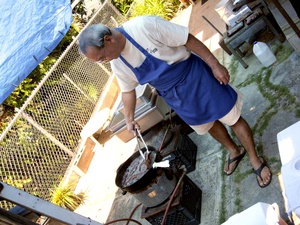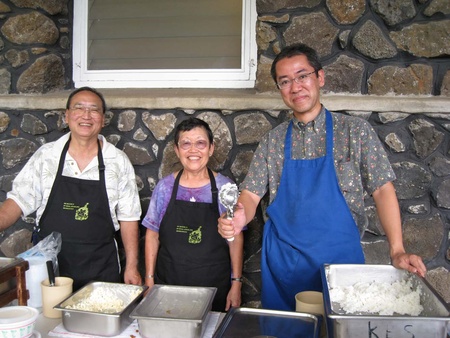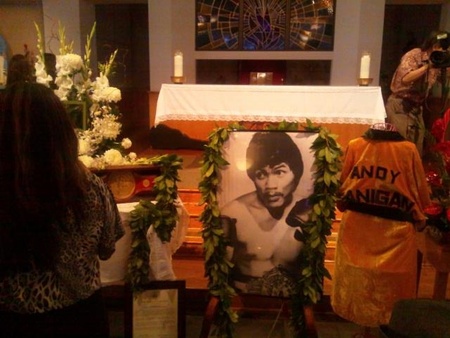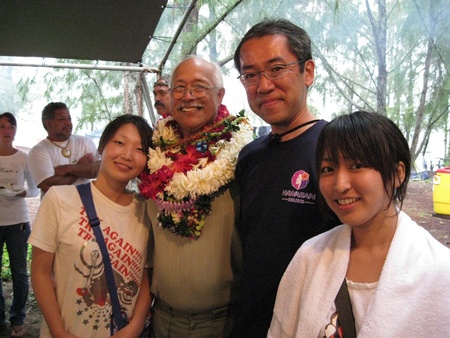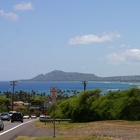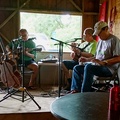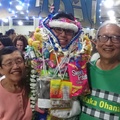The Japanese Mentality
I have been going to Hawaii for 20 years, and have lived there a few times during that time, so I have unintentionally participated in the ceremonies of the local community. When my English conversation skills were not sufficient (I think that everyday conversation is much more difficult than discussions in my field of expertise), I found it very bothersome. However, I thought that it would help me to gain a deeper understanding of my research field, so I decided to go out if invited.
There are many different types of rituals, but what we will focus on here is the "Ke" rituals rather than the "Hare" rituals.
Mr. M was the head chef of a famous hotel in Waikiki, and later served as the cafeteria manager of an elementary school. He was frequently asked to provide catering services, and was happy to oblige at no extra cost. He was even asked by the Governor of Hawaii, and helping out at that time was my first experience in catering.
One day, Ms. M was asked by a Hawaiian friend to do the catering for a family member's funeral. Since I had been staying in Hawaii for a long time, I joined Ms. L from early in the morning to help them. At around 10 o'clock, the food was brought into the hallway of the funeral home on Nuuanu Avenue in Honolulu, and preparations were made. I watched the ceremony from outside. Cars arrived one after another, and large Hawaiian people entered the hall one after another. The deceased was an ordinary old lady. Many people came, not only family members but also people who were related to the deceased, and it became a lively funeral.
Once the funeral was over without incident, it was time for lunch. Naturally, there were long lines for the food we served, and some people had to queue up again and again for refills of M's beef stew. Some even asked with straight faces, "Have they not brought the menu for the restaurant?" and "Where is the restaurant?"
It seemed as though even distant relatives had made the effort to attend this Hawaiian funeral.
About three years ago, I arrived in Honolulu early in the morning and went to a Filipino funeral. Perhaps because it was the funeral of a famous boxer, it was held on a grand scale at a Catholic church in Kalihi. When I asked Mr. M what time the funeral would be, he said, "It will be going on all day, so let's go after we finish eating." When I went there after breakfast, the church was overflowing with people. There were still empty seats in the large church, so the three of us sat down and listened to speeches and occasionally sang hymns. The funeral started in the morning and continued until around 2:00 p.m.
Compared to the large-scale funerals of Hawaiians and Filipinos, Japanese funerals are small and formal, with a very ritualistic atmosphere.
I once attended the funeral of a Japanese man who was the father of Professor C and the uncle of Professor A. I also attended the funeral of the father-in-law of M-san and L-san's best friend. Both were Buddhist ceremonies, held solemnly in the Wahiawa cemetery and at a funeral home in downtown Honolulu. At the end, we had a meal to break the fast, and then we went home with a little bit of a full stomach. This was exactly the same as a Japanese funeral.
I was also invited to the burial ceremony of Mr. L's ancestor. We first gathered at the ossuary of the temple in Wahiawa to receive the urn that had been left there for a long time. I was the only one who gathered there, apart from the three relatives. When I greeted the head priest, who had been living here for a long time after immigrating from Japan, I added with a smile, "I'm a Buddhist." After introducing myself, the head priest smiled and replied, "I'm a Buddhist, too!", and everyone burst into laughter. In such a homely atmosphere, we went to the Punchbowl Cemetery in Honolulu for the burial. We only had to travel in three cars, but there was not the slightest bit of loneliness, and it was a truly warm moment.
As such, we can see that Hawaiian and Filipino funerals, which are large family-like, are very different from Japanese funerals in terms of scale, duration, and atmosphere.
Hawaiian extended familyism
Having looked at "funerals" above, let's now finish by looking at examples of "hare," or happy occasions.
When I stayed there for a long time from summer to autumn eight years ago, I decided to visit a camp for Hawaiians celebrating their 60th birthdays. When I asked M and L what a "camp" was for a 60th birthday celebration, they just said that a camp is a camp. I couldn't connect the words 60th birthday and camping. They said they were going to eat lunch. So we went to Beach Park in Laie together in two cars.
There were five or six tents the size of elementary school classrooms set up, and about 100 people, men and women of all ages, were gathered there. Some were playing the ukulele, some were dancing the hula, some were grilling meat on the barbecue, some were swimming on the beach, and some were eating and drinking.
We enjoyed the mountain of food that was prepared for us and spent the time until the evening listening to a ukulele jam session with Mr. M and his friends.
What is surprising is that this camp can last for a week. And the number of people doesn't change much. I don't know if all Hawaiian 60th birthday parties are like this, but all the relatives gather, including distant relatives, and men and women of all ages gather in one place and continue camping outdoors.
What else can you call this but extended familyism?
Summary and hypotheses
From here on, I will present a hypothesis in lieu of a "summary." It is also a prediction that I am currently verifying.
Ms. M. frequently mentions how the next generation of fourth-generation Japanese men are calm and reserved, saying, "They don't say things clearly, so I can only guess what they're thinking, and it's exhausting." There seems to be a pretty clear gap between the third and fourth generation. This could be seen as one of the factors behind the "individualization" of Japanese people in Hawaii. So why is this the case? This is only a guess, but I wonder if the coexistence of Japanese and American things in Japanese society, with Japanese things becoming stronger especially among the younger generations (for example, the fourth generation), has created a generational gap and caused Japanese people to become "individualized." Is it too much to see a cultural "generational regression" here?
Let's look at it from a different perspective. Isn't the "individualization" of Japanese Americans a stage in the hybridization of identities in a sense? Sometimes it seems like they are placing more importance on a different identity than being strongly conscious of their ethnicity. In "Part 5: Japanese values that may be disappearing - The changing culture of Hawaii," I introduced a story in which Hawaii was likened to "stew." Although both the ingredients and the soup are themselves, perhaps the basis of identity is shifting from the ingredients (ethnicity) to the soup (Hawaiian). Rather than being conscious of their ethnicity or being Japanese, perhaps they position themselves in the category of "Hawaiian" and base their identity on more specific things. As mentioned above, this leads to the fragmentation of human groups.
Nikkei people live their daily lives in small family units, but the ties between relatives are not necessarily weak, and they gather together quite frequently. It's just that the scale is smaller than that of other ethnic groups. I wrote about this in detail in "The 4th Garage Party." If one of your parents or grandparents is of Okinawan descent, they gather even more frequently. I would like to continue to participate in such events as much as possible and carefully confirm the hypothesis stated above.
This time, I would like to close this article by generating a hypothesis.
© 2016 Seiji Kawasaki


